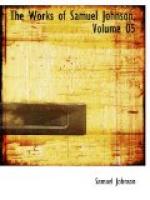The reformation did not immediately arrive at its meridian, and though day was gradually increasing upon us, the goblins of witchcraft still continued to hover in the twilight. In the time of queen Elizabeth was the remarkable trial of the witches of Warbois, whose conviction is still commemorated in an annual sermon at Huntingdon. But in the reign of king James, in which this tragedy was written, many circumstances concurred to propagate and confirm this opinion. The king, who was much celebrated for his knowledge, had, before his arrival in England, not only examined in person a woman accused of witchcraft, but had given a very formal account of the practices and illusions of evil spirits, the compacts of witches, the ceremonies used by them, the manner of detecting them, and the justice of punishing them, in his dialogues of Daemonologie, written in the Scottish dialect, and published at Edinburgh. This book was, soon after his accession, reprinted at London; and, as the ready way to gain king James’s favour was to flatter his speculations, the system of Daemonologie was immediately adopted by all who desired either to gain preferment or not to lose it. Thus the doctrine of witchcraft was very powerfully inculcated; and as the greatest part of mankind have no other reason for their opinions than that they are in fashion, it cannot be doubted but this persuasion made a rapid progress, since vanity and credulity co-operated in its favour, and it had a tendency to free cowardice from reproach. The infection soon reached the parliament, who, in the first year of king James, made a law, by which it was enacted, chap. xii. That, “if any person shall use any invocation or conjuration of any evil or wicked spirit; 2. or shall consult, covenant with, entertain, employ, feed or reward any evil or cursed spirit to or for any intent or purpose; 3. or take up any dead man, woman or child out of the grave,—or the skin, bone or any part of the dead person, to be employed or used in any manner of witchcraft, sorcery, charm or enchantment; 4. or shall use, practise or exercise any sort of witchcraft, sorcery, charm or enchantment; 5. whereby any person shall be destroyed, killed, wasted, consumed, pined or lamed in any part of the body; 6. That every such person, being convicted, shall suffer death.” This law was repealed in our time.
Thus, in the time of Shakespeare, was the doctrine of witchcraft at once established by law and by the fashion, and it became not only unpolite, but criminal, to doubt it; and as prodigies are always seen in proportion as they are expected, witches were every day discovered, and multiplied so fast in some places, that bishop Hall mentions a village in Lancashire, where their number was greater than that of the houses[2]. The Jesuits and Sectaries took advantage of this universal errour, and endeavoured to promote the interest of their parties by pretended cures of persons afflicted by evil spirits; but they were detected and exposed by the clergy of the established church.




